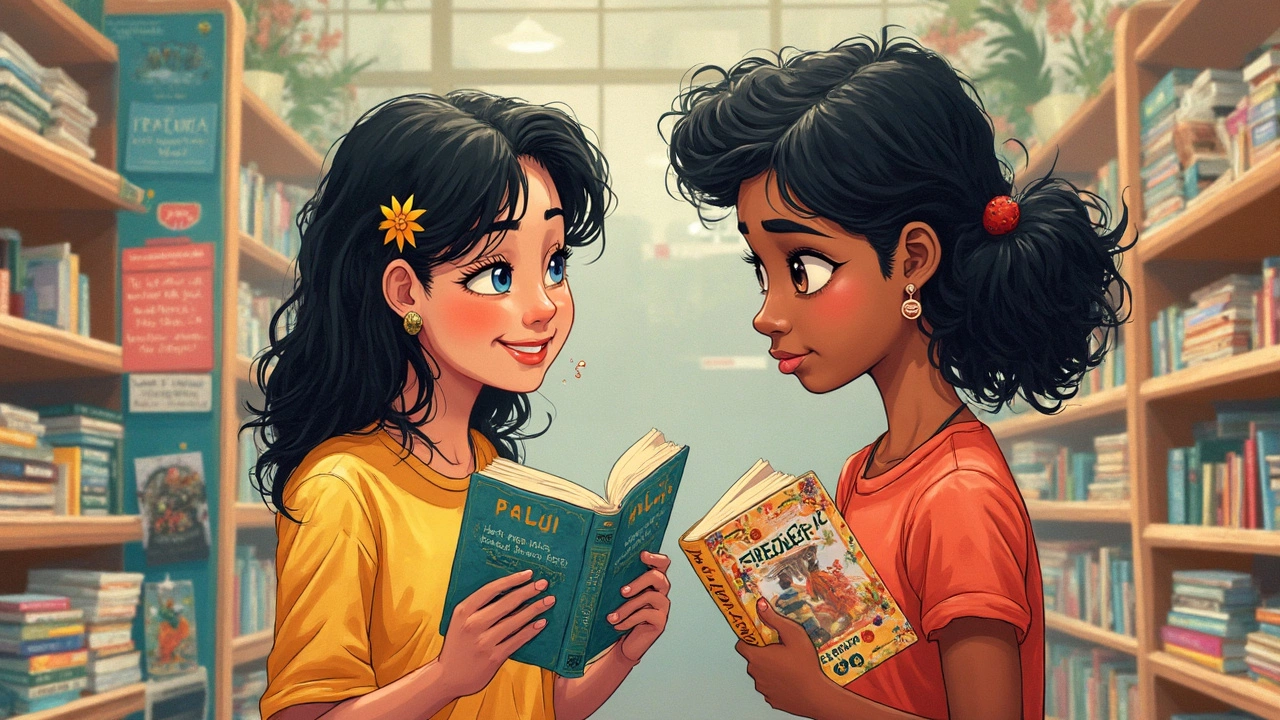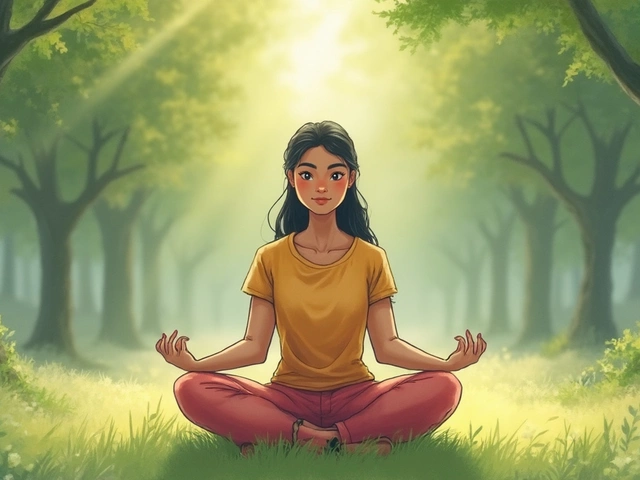
Not every book with a teenager on the cover is actually YA, and you’d be surprised how often that trips people up. When you flip through the shelves, you’ll see everything from fantasy dragons to real-life high school drama, all jammed into one section. The trick? It’s not just about the ages of characters or readers—it’s about the vibe, the voice, and even the issues the book dives into.
If you want a shortcut to figuring it out, the first big clue is this: YA books almost always have teen protagonists, usually between 14 and 18. But that’s not the whole story. The big thing is the focus on self-discovery, firsts (first kiss, first heartbreak, first time leaving home), and figuring out your place in the world. YA doesn’t shy away from tough stuff, but it keeps the perspective fresh and right in the middle of growing up—not looking back years later.
You don’t have to be a teen to enjoy YA, and there are plenty of adults who grab these books for the fast pace, emotional punch, and relatable struggles. The writing is clear, usually fast-moving, and not weighed down with complicated words. If you’re scanning a few pages and it feels like the author is talking to you, not over your head or way beneath it, that’s a classic YA move.
- Who's the Main Character?
- Age Range: Readers and Characters
- Themes and Issues You’ll Find
- Style, Tone, and Language
- What YA Isn’t: Common Mix-Ups
- How to Decide If It’s Right for You
Who's the Main Character?
Here’s something almost every YA fiction book has in common: the main character is a teenager. It doesn’t matter if they’re dealing with a magic apocalypse or just trying to survive math class—if they’re between 14 and 18 years old, you’re probably looking at a YA title. This isn’t just a random rule. Publishers and authors design these stories so teens can see themselves in the main role, facing the same kind of decisions (and screw-ups) they might be dealing with in real life.
Want some real examples? Katniss Everdeen in "The Hunger Games" is 16 when the story starts. Starr Carter in "The Hate U Give," also 16. Even Harry Potter, in his later adventures, fits right into this age zone. Authors stick to this formula because studies repeatedly show that readers want leads they relate to, especially during those years when everything changes so fast. According to a survey by the YA publishing house HarperCollins, over 80% of YA bestsellers star characters aged 15 to 17.
One more thing: these characters aren’t just props—they drive the plot. Most YA books are told through that main character’s eyes, first-person or tight third-person. This means you get the world from their perspective, not a distant adult looking back or narrating from the outside. That personal point of view pulls you straight into their struggles, whether it’s landing a spot on the soccer team, surviving their first breakup, or standing up for what’s right.
Here’s a quick breakdown of main character ages in some top YA books:
| Book Title | Main Character | Age |
|---|---|---|
| The Hunger Games | Katniss Everdeen | 16 |
| The Fault in Our Stars | Hazel Grace Lancaster | 16 |
| Eleanor & Park | Eleanor / Park | 16 |
| Divergent | Tris Prior | 16 |
| Simon vs. The Homo Sapiens Agenda | Simon Spier | 17 |
The takeaway: if the story follows a teen figuring out life as it comes, you’re in YA territory.
Age Range: Readers and Characters
If you’re trying to put your finger on what makes a book solidly YA, zero in on age. Both the typical reader and the main character almost always line up with the teen years. Most YA stories have protagonists between 15 and 18. Think Katniss from The Hunger Games (16) or Miles in Looking for Alaska (16). Authors aren’t pulling these numbers out of a hat—publishers know teens want to see themselves in the story, going through stuff that feels real for their age.
The target audience for YA fiction is usually 12 to 18, but let’s be honest, readers can range from middle school all the way to adults who just want a good coming-of-age story. The rough rule: if the main character’s age is under 12, it’s middle grade; over 18 and dealing with adult life, it’s new adult or straight-up adult fiction. YA sticks to that high school range—first jobs, prom, pressuring parents, finding your own crew.
Why does this matter? With YA, the experiences, decisions, and problems are always filtered through a teen’s eyes. You won’t get twenty-somethings worrying about office politics, or nine-year-olds dealing with playground squabbles as the focus. Everything is about the big transitions—friendships shifting, first love, breakups, and choices that can feel like the end of the world.
- Main character: Usually ages 14–18
- Intended reader: Usually 12–18 (but adults read these books too)
- Plot focus: Teen-centric problems, not kid stuff, not real adulting
This age focus is a dead giveaway for spotting actual YA fiction. So if you see an older protagonist or super heavy adult themes, it’s probably not YA, even if it’s sitting in the teen section by mistake.
Themes and Issues You’ll Find
Themes in YA fiction usually hit right where it hurts—or matters most—when you're figuring out your life. Expect books to get straight into stuff like friendship drama, family problems, crushes, identity, and figuring out how you fit in. It’s not all love triangles and prom night, though. Some of the best YA books dig into way bigger stuff: mental health, bullying, fitting in as an outsider, trauma, or surviving things as tough as abuse or coming out to your family. These themes are handled in a way that feels honest and current, not preachy or old-fashioned.
Authors don’t skip “the big questions” either. You’ll find stories asking what it means to be a good friend, how to stand up for yourself, what happens when someone betrays you, and how to bounce back from making big mistakes. Modern bestsellers get really specific, too, with stories about racism, social justice, gender, immigration, or life online. It’s not unusual to see characters dealing with depression, anxiety, eating disorders, or addiction in a way that feels real—not just a “lesson” for the reader.
- Growth and change: Coming-of-age is the core of almost every YA novel.
- Relationships: Not just romance, but also best friends, family, and found family.
- Choices and consequences: Making mistakes, learning, and sometimes paying the price.
- Self-identity: Figuring out who you are—sometimes in a world that doesn’t make it easy.
How common are these issues in YA? Check out this breakdown of top topics featured in best-selling YA fiction from 2021-2024, pulled from popular reading lists and publisher reports:
| Theme or Issue | % of Top YA Books (2021-2024) |
|---|---|
| Romantic Relationships | 68% |
| Family and Friendship | 74% |
| Mental Health | 37% |
| Social Justice/Racism | 33% |
| LGBTQ+ Identity | 29% |
| Bullying/Peer Pressure | 41% |
So if the book goes deep into these topics, with a teen point of view front-and-center, odds are good you’ve found yourself a YA novel. No lecture, just stories about dealing with life—messy, complicated, and pretty relatable for anyone, even if you’re not the one going to high school every day.

Style, Tone, and Language
When it comes to YA fiction, the style, tone, and language are totally tuned in to what teens actually sound like and care about. You won’t see a bunch of overly fancy sentences or super complicated vocabulary. YA authors usually cut straight to the point, which makes the books easy to read but still packed with feeling. Short chapters, snappy dialogue, and relatable narration all help hook readers right from the start.
One thing you’ll notice: Authenticity matters. Authors work hard to nail teen slang, internet speak, and pop culture references, but they don’t go overboard or make it cringey. The emotional tone is front and center—whether it’s anger, heartbreak, or hope—because YA stories are about the lived experiences of teens, not just the plot twists. If a character says exactly what you were thinking or blows up over something that most adults would ignore, you’re probably holding a YA book.
Most YA books avoid talking down to the reader. The voice feels like it’s sitting next to you, telling you what really happened—not teaching you a lesson or showing off. As one editor at Scholastic said,
“YA readers demand honesty; they can spot fake emotion a mile away.”
Here’s what you’ll commonly spot in YA style:
- First-person or close third-person narration—so you’re right in the main character’s head.
- Realistic dialogue that mirrors how teens actually talk (but with enough editing to make sense).
- Fast pacing with high emotional stakes—nothing drags for too long.
- Clear language without a ton of technical jargon or long explanations.
If you start reading and it feels personal, honest, and almost raw, then it’s got the YA tone down. And if you finish a chapter faster than you expected, that’s definitely by design.
What YA Isn’t: Common Mix-Ups
One thing that trips up a lot of readers: just because a book has teens, doesn’t mean it’s YA. It’s a classic mix-up. Think about books like "The Catcher in the Rye" or "To Kill a Mockingbird." Both have young main characters, but they weren’t written for teens and don’t follow the usual YA formula. On the flip side, you’ll see some books marketed as YA because that’s where the big sales are, even if the story fits better in middle grade or adult fiction.
Here’s a quick way to avoid getting fooled:
- If the book comes from the main character’s young perspective and focuses on growing up, it’s a good bet it’s YA.
- If it’s written looking back as an adult or deals with heavy topics in a mature, detached way, it might not count as YA.
- Some thrillers and fantasy books with young characters get lumped into YA, but if most of the themes are too dark or the writing is way more complex, they’re probably adult books.
- Middle grade books (for ages 8-12) get tossed in sometimes, but those usually stick to lighter, simpler topics and younger characters.
Labels can get blurry, so publishers and bookstores don’t always help. Check this out for a sense of industry trends:
| Book Type | Main Character Age | Common Themes | Intended Audience |
|---|---|---|---|
| Middle Grade | 8-13 | Friendship, home, personal growth | Children |
| YA fiction | 14-18 | Identity, relationships, challenges | Teens, adults |
| Adult Fiction | 18+ | Work, marriage, long-term consequences | Adults |
The bottom line? YA fiction is its own thing. Just because a book has a teenager doesn’t lock it in. Look at voice, viewpoint, and themes. If it’s all about the firsts, the highs and lows of being a teen, and it talks straight to where you are (not from years in the future), you’re probably in the right section.
How to Decide If It’s Right for You
Standing in front of a whole wall of young adult fiction can get a bit overwhelming—how do you know if YA is truly your thing? Let’s cut straight to what helps most people decide.
First up, think about what you want from a book. YA fiction usually comes with characters who are figuring stuff out, taking risks, or dealing with big changes. If you want fast-moving stories, fresh takes, and tons of emotion, you’re in the right spot. On the flip side, if you’re hunting for stories about everyday adult life, slow-burn romances, or political power moves, adult fiction might work better.
Here’s what you can do to check if YA fits:
- Skim the first chapter—YA books tend to grab you immediately. If it opens with action, drama, or a strong inner voice, it’s probably YA.
- Look at the topics: Common YA themes are identity, crushes, friendship drama, and trying new things for the first time. If this sounds like what you need, you’ll likely enjoy it.
- Check reviews or online ratings. Goodreads, for instance, has tons of YA book lists and honest reactions. See if adults are reading and loving it too, or if it’s mostly teens.
- If you’re a teacher, parent, or librarian, pay attention to your reader’s maturity level. Some YA books talk about mental health, grief, violence, or serious topics—nothing is really off limits. But the approach will suit someone in the process of growing up.
Bonus tip: Don’t worry about being “too old” or “too young” for YA. Publishers Weekly did a survey and found more than half of YA readers are over 18. The best way to decide is just to try a book and see how it makes you feel. If you love it, you fit the target group—no age check needed.


